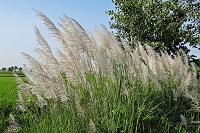Preliminary Investigation of Antipyretic Activity of Trinpanchmool Extracts
Keywords:
Trinpanchmool, Hydroalcoholic, Antipyretic, Brewer’s yeast methodAbstract
Current research work is to evaluate the antipyretic activity of hydroalcoholic extract of trinpanchmool on the wistar rats. Brewer’s yeast induced pyrexia method was used to evaluate febrifuge effect of trinpanchmool extract along with its comparison with its individual constituents on the wistar rats. Darbh, Ikshu and SAR was having better antipyretic activity than the standard drug paracetamol. Combination of the drugs was having better antipyretic that paracetamol but lesser than the individual drugs. Trinpanchmool and its individual drugs are having febrifugatic effect better than our standard paracetamol.
References
Ashok Kumar K et al. Chemical
Composition & antimicrobial activity of
the essential oil of Desmostachya
bipinnata linn. International Journal of
Phytomedicine. 2010;2:436-439.
Medha M Hegde et al. Assessment of
antidiarrhoeal activity of desmostachya
bipinnata linn.(Poaceae) root extracts.
Boletin Latinoamericano Y Del caribe De
Plantas medicinales Y Aromaticas.
;9(4):312-318.
Mohammad A Ramadan & N A Safwat.
Antihelicobacter activity of a flavanoid
compound isolated from Desmostachya
bipinnata. Australian Journal of Basic &
Applied Sciences. 2009;3(3):2270-2277.
Sabina Shrestha et al. A New xanthene
from Desmostachya bipinnata (L.) stapf
inhibits signal transducer and activator of
transcription 3(STAT3) and low density
lipoprotein oxidation. J Korean Soc. Appl.
Biol. Chem. 2011;54(2):308-311.
Md. Mynol Islam Vhuiyan et al.
Antidiarrhoeal & CNS depressant activity
of methanolic extract of Saccharum
spontanuem Linn. Stamford Journal of
Pharmaceutical Sciences.
;1(1&2):63-68.
Ghani A. Medicinal plants of Bangladesh
with chemical constituents and uses, 2nd
edn pp 369. The Asiatic society of
Bangladesh, Dhaka, 2003.
Nikodemus TW, Padmawinata K,
Soetarno S. Phenolic acids from imperata
cylindrical (L) Raeusch. Var. Major
(Nees) c.e. hubb. Medicaments et
ailments: L` approche
ethnopharmacologique. 337.
EE Mak-mensah, G Komlaga, E O
Terlabi. Antihypertensive action of
ethanolic extract of Imperata cylindrical
leaves in animal models. Journal of
Medicinal Plants Research.
;4(14):1486-1491.9. Dae-young Lee et al. A new lignin
glycoside from the rhizomes of imperata
cylindrica. Journal of asian natural
product research. 2008;10(4):299-302.
Rahar Sandeer et al. Medicinal Aspects of
Saccharum munja. Research journal of
Pharmacy & Technology. 2010;3(3):636-
Joaquim M Duarte-Almeida et al.
Antioxidant activity of phenolic
compounds from sugar cane (Saccharum
officinarum L) Juice. Plant foods for
Human Nutrition. 2006;61:187-192.
Jain BB et al. Antipyretic activity of
aqueous extract of leaves of cocculus
hirsutus. Indian Journal of Natural
Product. 2000;23:26-29.
Metowogo K et al. Antiulcer and
Antiinflammatory Effects of
Hydroalcohol Extracts of Aloe buettneri
A. Berger Liliaceae). Tropical journal of
pharmaceutical research. 2008;7:907-912.



